Unicamp – Campinas State University
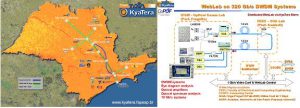 KyaTera Optical Testbed Platform
KyaTera Optical Testbed Platform
This is a optical testbed platform interconecting almost all R&D optical communication laboratories within the State of São Paulo. The tests of the devices developed by Fotonicom, as well the products deployed by ourt industrial partners, will be performed in KyaTera testbed. This stable network is conected with another academic networks (ANSP, RNP, Ipê e GIGA) and is part of the Global Lambda Internet Facility (GILF).
Optical Communications Lab – “Gleb Wataghin” Physics Institute (IFGW)
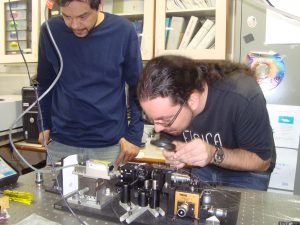 This is a multi-user lab with complete instrumentation tools for optical systems and for some integrated devices characterization. Labs within S.Paulo State are able to remotly access this lab due to its interfaces library between computer and instruments, and also due to its KyaTera conectivity. We can highlight these ones: one 10 Gbps BERT (Bit-Error-Rate Tester), 50 GHz osciloscopes. Optical Spectrum Analyser (OSA), with bandwidth and resolution of 10pm, High Resolution OSA (1 MHz RBW), Optical Time Domain Reflectometer (OTDR), 20 GHz Sintetized Signal Generator, Chromatic Dispersion Analyser, 30 GHz Electrical Spectrum Analyser , Tunable Lasers, and one C band DWDM source of 32 channels.
This is a multi-user lab with complete instrumentation tools for optical systems and for some integrated devices characterization. Labs within S.Paulo State are able to remotly access this lab due to its interfaces library between computer and instruments, and also due to its KyaTera conectivity. We can highlight these ones: one 10 Gbps BERT (Bit-Error-Rate Tester), 50 GHz osciloscopes. Optical Spectrum Analyser (OSA), with bandwidth and resolution of 10pm, High Resolution OSA (1 MHz RBW), Optical Time Domain Reflectometer (OTDR), 20 GHz Sintetized Signal Generator, Chromatic Dispersion Analyser, 30 GHz Electrical Spectrum Analyser , Tunable Lasers, and one C band DWDM source of 32 channels.
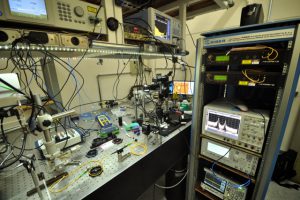 Devices Researches Lab – “Gleb Wataghin” Physics Institute (IFGW)
Devices Researches Lab – “Gleb Wataghin” Physics Institute (IFGW)
It is a complete nanofotonic device characterization laboratory, including various adjustable lasers, optical amplifiers, high-speed receivers, optical and electrical spectrum analyzers, and high-frequency RF signal generators. Photo montages and electro-luminescence are also available to characterize nano-photonic devices based on active III-V, such as nanolasers. The laboratory also has a clean room for optical lithography, metal deposition and wet corrosion of nano-photonic devices, including a 1-μm resolution direct laser lithography system.
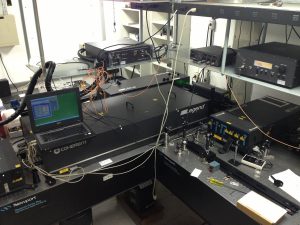 Ultrafast Phenomena Lab – “Gleb Wataghin” Physics Institute (IFGW)
Ultrafast Phenomena Lab – “Gleb Wataghin” Physics Institute (IFGW)
The ultra-fast characterization lab allows the investigation and characterization of optical phenomena in the femtosecond scale focusing on new optical nanomaterials such as graphene, polymers and other materials with quantum confinement as heterostructures. The main tool of the Laboratory is a Ti laser system: amplified sapphire coupled to Parametric Optical Amplifiers (OPA’s) delivering ~ 80fs pulses in 800nm with 1mJ per pulse. The OPA covers the entire range of near infrared in the range.
Photonics and Microwave lab of Electric and Computers School of Engineering (FEEC)
This laboratory is specialized in the interface between optics and RF. Featuring some optical tables in a clean room environment and many microwave devices. This lab is equipped with a variety of multi-GHz RF generators and analyzers, including a real-time 60 GHz oscilloscope and 40 GHz network analyzer. It also offers a wide range of high-speed optical receivers (70 GHz) and modulators (40 GHz), allowing the investigation of advanced optical modulation formats such as DP-QPSK, 16QAM and DP-DP-64QAM
Semiconductor Components Center – CCS
This is a large multi-disciplinary center at UNICAMP, with facilities for micro and nano manufacturing, widely used by integrated device manufacturing groups. In an area of 700 m2, with clean room of 150 m2 , various equipments are installed, such as photolithography systems, ion implanters, oxidation furnaces, Steam Chemical Deposition Systems (CVD), Metallization Systems, Plasma Engraving Systems . In addition, a complete set of characterization systems, such as infrared spectroscopy and electrical system characterization. CCS also offers advanced nanofabrication tools, such as an electron beam / ion beam dual focusing (FIB) system, and an electron beam lithography system. They are available to investigate and debug devices manufactured with characterization tools, such as micro-Raman / atomic force microscopy system and scanning electron microscopy.
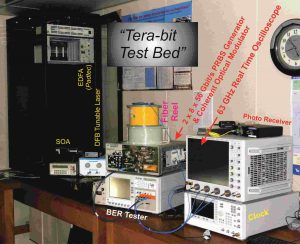 Laboratório Computacional Faculdade de Engenharia Elétrica e de Computação (FEEC)
Laboratório Computacional Faculdade de Engenharia Elétrica e de Computação (FEEC)
In addition to several high-performance workstations, photonics and electromagnetic simulators developed by the lab or comercial ones, this lab also has a Beowulf 5-node cluster, totaling 80 CPU cores, 640 GB of RAM and 14,336 distributed CUDA COLORS that produces a Computing power of almost 7 TFlops.
Faltou a infra do IC
